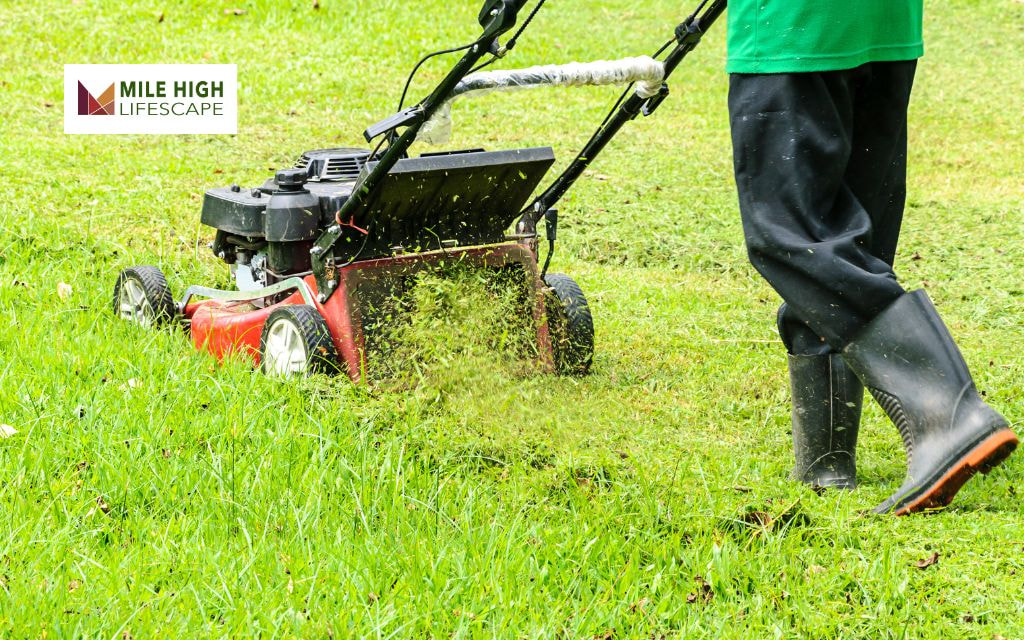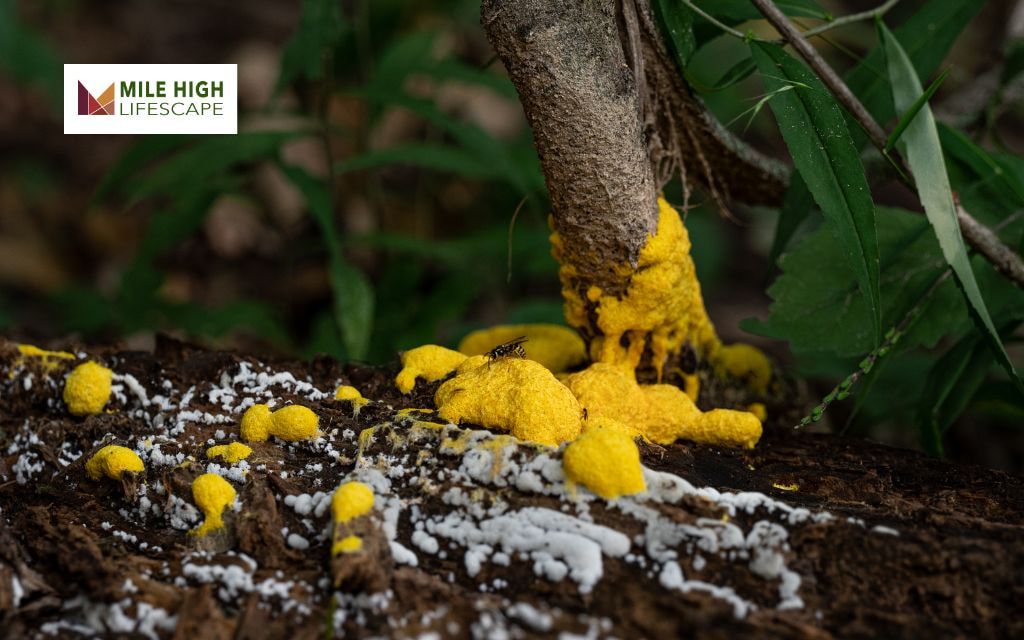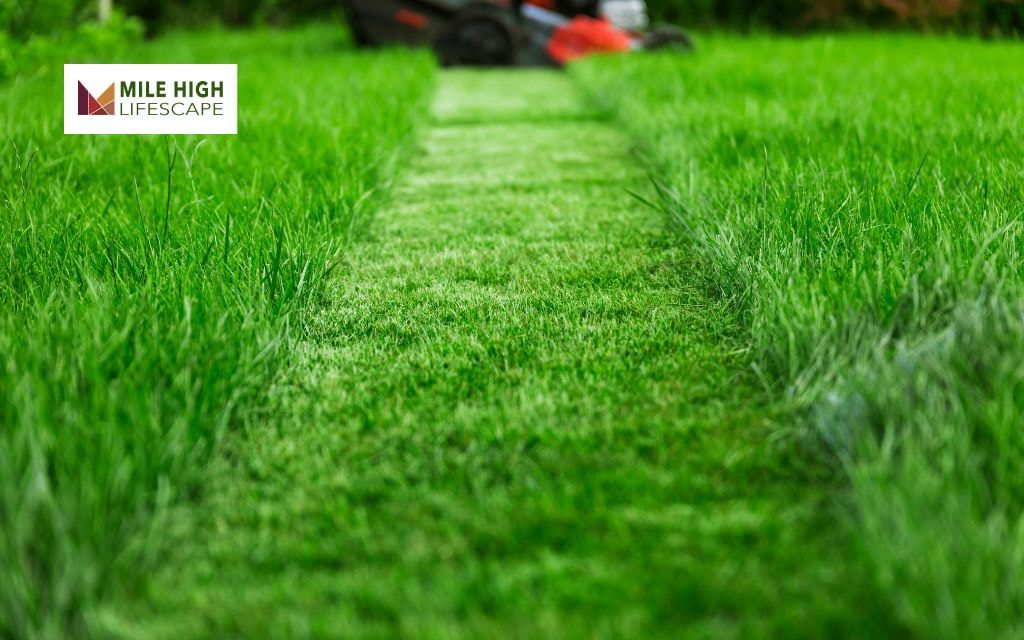Ever wondered why achieving that picture-perfect lawn seems twice as challenging in Denver? You’re not imagining it! Denver’s unique semi-arid climate throws a gauntlet of obstacles at even the most dedicated lawn enthusiasts.
After months of winter dormancy where your lawn has endured freezing temperatures, snow cover, and perhaps even snow mold, spring represents your golden opportunity to revitalize your outdoor space.
In this comprehensive guide, we outline 10 essential spring lawn care steps to revitalize your grass and create a lush outdoor space that will thrive throughout the growing season.
Clean Up Debris
Start your spring lawn care by removing accumulated debris from winter. Fallen leaves, twigs, and other organic matter trap moisture against the grass, creating ideal conditions for disease and preventing essential sunlight from reaching the soil.
Use a sturdy rake or leaf blower to clear all debris efficiently. Focus on corners and areas where wind typically deposits material. This simple first step improves air circulation, reduces fungal growth risk, and allows your grass to absorb nutrients properly.
Remember to wear gloves to protect your hands and dispose of collected debris in your compost bin or yard waste container.
Rake and Dethatch
After clearing surface debris, address the layer of dead grass and roots between green vegetation and soil – known as thatch. While a thin thatch layer (less than ½ inch) benefits your lawn by retaining moisture and providing insulation, excessive buildup prevents water, air, and nutrients from reaching the roots.
For light thatch problems, a deep rake with firm pressure works effectively. For severe buildup exceeding ½ inch, consider using a power dethatcher or vertical mower. Schedule dethatching when your grass shows active growth signs to ensure rapid recovery.

Denver lawns typically benefit from dethatching in late April when soil temperatures consistently reach above 50°F. This process stimulates new growth and prepares your lawn for the fertilization and aeration steps to follow.
Aerate the Soil
Denver’s clay-heavy soil compacts easily, especially in high-traffic areas. Soil compaction restricts root growth, impedes water absorption, and limits nutrient uptake. Aeration creates small holes in your lawn to loosen soil, allowing oxygen, water, and nutrients to penetrate deeper.
For most residential lawns, a core aerator that removes small plugs of soil is suitable for Colorado springs lawn aeration. These machines can be rented from local hardware stores or equipment rental centers.
Focus on compacted areas but aerate the entire lawn for consistent results. Leave the soil cores on the lawn – they break down quickly and return valuable nutrients to the soil.
Aeration works best when soil is moist but not saturated, making spring the perfect time for this crucial lawn care task.
Overseed Bare Patches
Winter damage and pet activity often create bare patches in lawns. Overseeding lawn in spring these areas enhances density, improves appearance, and increases your lawn’s resistance to weeds, disease, and drought.
Select grass varieties suited to Colorado’s climate. Kentucky bluegrass performs well in sunny areas, while fine fescue tolerates shade. For maximum drought resistance, consider tall fescue varieties.
Before applying seed, rake the soil surface to ensure good seed-to-soil contact. Spread seed evenly using a broadcast spreader, apply a thin layer of compost over the seeds, and water lightly twice daily until germination occurs.
Avoid mowing these areas until new grass reaches at least 3 inches in height to prevent uprooting delicate seedlings.
Fertilize Appropriately
Spring lawn fertilization provides essential nutrients that support robust growth after winter dormancy. However, timing and product selection matter significantly in Denver’s climate.
Apply a balanced, slow-release fertilizer with an NPK ratio around 20-5-10 in mid-spring when your lawn shows active growth. This ratio provides nitrogen for leaf development, phosphorus for root growth, and potassium for overall plant health. Consider conducting a soil test first to determine specific nutrient deficiencies and avoid over-application.
For an eco-friendly approach, use organic fertilizers like compost, which improve soil structure while providing nutrients.
Apply fertilizer with a broadcast spreader in two perpendicular passes for even distribution, and water immediately afterward to activate the product and prevent fertilizer burn.
Implement Weed Control
Apply pre-emergent herbicides before soil temperatures reach 55°F (typically early April in Denver) to prevent crabgrass and other summer annual weeds from germinating. For existing weeds, spot-treat with selective post-emergent herbicides that target specific weed types without harming turfgrass.
Always follow product instructions precisely for application rates and timing. Consider organic alternatives like corn gluten meal for pre-emergent control or vinegar-based solutions for spot treatment.
Remember that maintaining proper mowing height and fertilization practices naturally discourages weed growth by promoting dense turf that outcompetes weeds.
Mow Regularly and Maintain Equipment
Proper mowing practices promote lateral growth, resulting in a denser lawn that resists weeds and tolerates drought better. As spring progresses, knowing the best time to mow lawn in spring helps you establish a regular mowing schedule that maximizes these benefits.
Maintain a cutting height of 2.5 to 3 inches for most Denver lawns – taller grass develops deeper roots and shades the soil, reducing water evaporation and weed germination. Never remove more than ⅓ of the grass blade in a single mowing to avoid stressing the plants.
Before starting your mowing routine, sharpen mower blades to ensure clean cuts that heal quickly. Dull blades tear grass, creating entry points for disease and increasing water loss. Also check your mower’s oil, air filter, and spark plug to ensure optimal performance throughout the season.
Check out this guide on spring lawn mower maintenance can help you get your equipment ready easily.

Water Wisely
Establishing proper watering habits in spring sets the foundation for a water-efficient lawn during summer’s heat. Denver’s climate requires strategic irrigation to maintain lawn health while conserving water.
Water deeply but infrequently – about 1 inch per week including rainfall – to encourage deep root growth. Schedule irrigation for early morning (5-9 AM) when evaporation rates are lowest and wind is typically calm.
Adjust watering frequency based on weather conditions, reducing during rainy periods and increasing during hot, dry spells. Check out this guide on when to start watering lawn in spring for the best results in Denver’s climate.
Consider installing a smart irrigation controller that adjusts watering schedules based on local weather data, potentially reducing water usage by 15-30%. Check sprinkler heads regularly for proper operation and coverage to prevent dry spots or wasteful runoff.
Edging and Mulching
Create clean boundaries between your lawn and garden beds with proper edging techniques. Use a mechanical or manual edger to cut 2-3 inches deep along sidewalks, driveways, and gardens. This creates barriers against grass runners and defines your landscape.
After edging, apply 2-3 inches of organic mulch like wood chips or shredded bark around plants to suppress weeds, conserve moisture, moderate soil temperature, and create visual definition. Keep mulch 2-3 inches away from stems and trunks to prevent disease problems from excess moisture.
Pest Scouting
Monitor your lawn regularly for spring pests that emerge as temperatures rise. Common Denver lawn destroyers include billbugs (small weevils laying eggs in stems), white grubs (C-shaped larvae eating roots), sod webworms (caterpillars creating brown patches), and chinch bugs (sap-sucking insects causing yellow-to-brown patches).
Identify infestations by checking for irregular brown areas that don’t green up with watering.
To check for soil-dwelling pests, cut three sides of a 1-foot turf square and fold it back—finding more than 5-10 grubs per square foot requires treatment. Use targeted solutions at vulnerable life stages rather than broad-spectrum chemicals that harm beneficial insects.
Spring Lawn Treatment: How To Prevent Common Problems
Identify potential issues early to avoid significant damage later. Denver lawns commonly face challenges from snow mold, red thread fungus, and grub damage in spring. Regular inspection combined with proper cultural practices prevents most problems from developing into serious issues.
- Snow Mold Identification and Treatment
Fill and level winter vole runways with topsoil, then overseed damaged areas with matching grass varieties. Remove debris piles that shelter these rodents around your property. For persistent problems, consider humane trapping or installing buried hardware cloth barriers around valuable plants, especially in areas with recurring annual damage.
- Red Thread Fungus Management
Red thread appears as pink to red patches with thread-like structures visible on grass blades. This fungus thrives in cool, wet conditions with low nitrogen levels.
Correct nitrogen deficiencies with a balanced spring fertilizer application. Improve drainage in affected areas and reduce watering frequency while maintaining adequate depth. For severe cases, apply fungicide labeled specifically for red thread disease.

- Grub Prevention and Control
Examine soil in areas where grass pulls up easily by cutting a small square of turf and inspecting the top few inches of soil. More than 5-10 grubs per square foot indicates treatment is necessary.
Apply beneficial nematodes as a natural control method in early spring when soil temperatures reach 55°F. For severe infestations, use targeted grub control products following label instructions precisely. Maintain proper irrigation to help grass recover from minor grub damage.
- Vole and Mole Damage Repair
Look for circular patches of matted, gray or pinkish grass as snow melts—the telltale sign of snow mold. Gently rake affected areas to improve air circulation and dry out fungal colonies. Apply fungicide labeled for snow mold only if damage affects more than 25% of your lawn. Prevent future outbreaks by avoiding high-nitrogen fertilizers in late fall and removing snow from problem areas when possible.
Mistakes to Avoid in Denver Spring Lawn Care
Even well-intentioned lawn care efforts can backfire if you make these common mistakes.
- Overwatering
Frequent shallow watering creates weak root systems that stay near the surface instead of growing deep into the soil. This makes your lawn vulnerable to drought stress when summer heat arrives.
Overwatering also promotes fungal diseases like dollar spot and brown patch, which thrive in constantly moist conditions. Instead, water deeply 1-2 times weekly, allowing soil to dry slightly between irrigation cycles to encourage roots to grow downward in search of moisture.
- Mowing Too Short
Cutting grass below 2.5 inches – known as “scalping” – exposes soil to direct sunlight, increasing evaporation and soil temperature. This stress creates perfect conditions for weed seeds to germinate and compete with your turfgrass.
Short grass also has less leaf surface for photosynthesis, reducing the plant’s ability to produce energy for growth. Maintain a 2.5-3 inch cutting height and never remove more than one-third of the grass blade in a single mowing session.

- Using Improper Fertilizer
Applying high-nitrogen “quick green” fertilizers causes rapid leaf growth that outpaces root development. This creates grass that looks temporarily lush but lacks resilience to stress.
Denver’s alkaline soils often have adequate phosphorus, so using standard “starter” fertilizers can create nutrient imbalances that contribute to water pollution. Conduct a soil test to determine actual nutrient needs and select slow-release formulations that provide steady nutrition without growth surges.
- Skipping Aeration
Neglecting annual aeration allows soil to become increasingly compacted, especially in high-traffic areas. Compacted soil restricts water infiltration, leading to runoff and wasted irrigation. Root growth becomes limited, reducing the lawn’s ability to access nutrients and moisture. Oxygen exchange in the soil diminishes, hindering beneficial microbial activity essential for decomposing thatch and organic matter. Core aeration in spring creates pathways for air, water, and nutrients while alleviating stress on grass roots.
- Poor Equipment Maintenance
Using dull mower blades tears grass rather than cutting it cleanly, creating ragged edges that lose moisture and become entry points for disease. Failing to service your mower’s engine reduces efficiency and can cause uneven cutting patterns.
Clean equipment after use prevents spreading disease organisms between areas of your lawn. Sharpen blades at least twice per season and perform basic engine maintenance according to manufacturer guidelines to ensure optimal lawn care results.
- Neglecting pH Imbalances
Denver’s native soils tend toward alkalinity (pH 7.0-8.3), which can limit nutrient availability to grass roots. Failing to test and correct pH leads to ineffective fertilization as nutrients become chemically bound in the soil.
Address high pH gradually with applications of elemental sulfur or acidifying fertilizers. Most turfgrasses perform best in slightly acidic to neutral conditions (pH 6.0-7.0), where nutrient availability reaches optimal levels.

Conclusion
Implementing these 10+ essential spring lawn care steps creates the foundation for a healthy, vibrant lawn throughout Denver’s growing season. While the process requires time and effort, the results deliver substantial rewards: a resilient, lush green space that enhances your property and provides a beautiful outdoor living area.
Remember that consistency matters more than perfection – develop a regular maintenance routine based on these principles and adjust as needed for your specific lawn conditions. With proper care, your Denver lawn will thrive despite our challenging climate.
For a more detailed look at how your lawn care tasks fit into the bigger picture throughout the year, check out our comprehensive spring lawn care schedule as part of the Denver Lawn Care Calendar. It breaks down month-by-month tips to keep your yard healthy and vibrant in every season.
Mile High Lifescape’s professional lawn care spring services address Denver’s unique challenges with specialized expertise and commercial-grade equipment. We use soil testing and integrated pest management that reduce chemicals while maximizing results.
Our technicians are trained in Front Range-specific techniques and select regionally-appropriate grass varieties for Denver’s microclimates. We offer customizable service packages backed by our satisfaction guarantee, eliminating your need to invest in specialized tools.
Contact us today for a free consultation to transform your lawn with our professional lawn care services.
Frequently Asked Questions (FAQs)
When should I start spring lawn care in Denver?
Begin when soil temperatures consistently reach 50°F, typically late March to mid-April. Wait until the ground has thawed completely and daytime temperatures regularly exceed 60°F.
Is aeration necessary every spring?
Denver’s clay soils generally benefit from annual aeration, particularly in high-traffic areas. For established lawns with minimal use, aerating every other year may suffice. Monitor your lawn’s performance to determine your optimal schedule.
Can I overseed and apply pre-emergent weed control simultaneously?
No. Pre-emergent herbicides prevent all seed germination, including grass seed. Schedule these tasks at least 6-8 weeks apart, prioritizing based on your lawn’s specific needs.
How often should I water my lawn in spring?
Water once or twice weekly, providing approximately 1 inch total including rainfall. Adjust based on weather conditions. Test soil moisture by inserting a screwdriver – if it penetrates easily 6 inches deep, moisture is adequate.
What mower height is best for Denver lawns?
Maintain 2.5 to 3 inches for most Denver lawns. This promotes deep root development, shades soil to reduce weed germination, and improves drought tolerance. During peak summer heat, consider raising to 3-3.5 inches.
